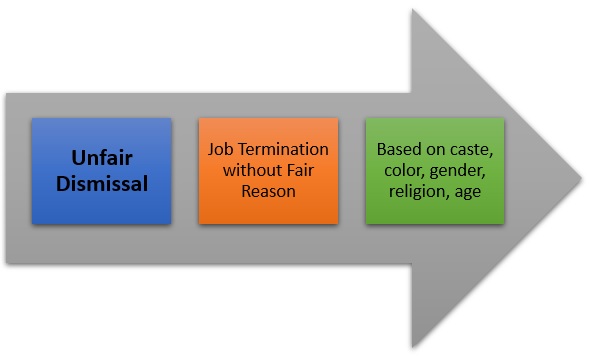- Business Concepts ›
- Human Resources (HR) ›
- Unfair Dismissal
Unfair Dismissal - Definition, Importance & Example
This article covers meaning & overview of Unfair Dismissal from HRM perspective.
Unfair Dismissal Definition
Unfair dismissal is an act of termination of the employment of the employee by the employer but is made without a good reason or is against the law of the country. Every country has laws to protect the employees and workers from unfair dismissal. In unfair dismissal, organizations usually try to force the employee to quit or resign if they feel that the employee should not work at that place by various means such as degrading the working conditions, assigning clerical work etc.
In case of misconduct taking place the procedure for dismissal of the employee has to be done with utmost care because a small lapse in the procedure would hand the benefit of doubt to the employee and the employee would not be dismissed. Many countries have regulations against unfair dismissal, there is a proper procedure that has to be followed to dismiss an employee and if that procedure is not followed then the dismissal of the employee is deemed unfair.
Job termination or dismissal can be of various types like fair dismissal, unfair dismissal, constructive dismissal, unjustifiable dismissal etc.

Importance of Unfair Dismissal
Every country has laws to protect the employee from unfair dismissal. The rules that an employee has to follow are given in three importing documents which are standing orders of the organization, the policies document of the organization and the appointment letter that was given to the employee at the time of hiring. In Australia, a dismissed employee cannot appeal for his/her own termination as being unfair, usually a union has to challenge the fairness of the dismissal. Employee’s dismissal would be deemed unfair if it is on the basis of discrimination or retaliation. Unfair dismissal also doesn’t oblige dismissal with notice for an employee. Under unfair dismissal protection, an employer cannot fire an employee because of the employee’s caste, creed, gender, age and race. An employer cannot fire the employee because the employee sued the employer a reason.
Read More
Difference Between Unfair Dismissal & Constructive Dismissal
Constructive dismissal, also known as constructive termination or constructive discharge is another concept but the difference is that the employee is forced to resign from the organization instead of the employer dismissing the employee, the employer creates a hostile work environment for the employee so that the employee resigns, some of the ways in which the employer creates a hostile work environment are changing shift timings, relocating the employee, demanding unreasonable amount of work with strict deadlines etc.
Example of Unfair Dismissal
Ajay was an employee for an organization named XYZ Limited. In 2008, XYZ Limited was going through a crisis situation and decided to retrench most of its employees to cut down on costs, Ajay was also dismissed from his/her job in the downsizing of the organization, Ajay had worked with the organization for over 10 years and by law of retrenchment FIFO principle applies which means that if an organization has to retrench its employees it starts with the person hired recently and then goes backwards. Since Ajay had worked for a long time and was dismissed eventhough there were employees who were hired after Ajay, His/her dismissal would be deemed unfair according to the FIFO principle.
Hence, this concludes the definition of Unfair Dismissal along with its overview.
This article has been researched & authored by the Business Concepts Team which comprises of MBA students, management professionals, and industry experts. It has been reviewed & published by the MBA Skool Team. The content on MBA Skool has been created for educational & academic purpose only.
Browse the definition and meaning of more similar terms. The Management Dictionary covers over 1800 business concepts from 5 categories.
Continue Reading:
What is MBA Skool?About Us
MBA Skool is a Knowledge Resource for Management Students, Aspirants & Professionals.
Business Courses
Quizzes & Skills
Quizzes test your expertise in business and Skill tests evaluate your management traits
Related Content
All Business Sections
Write for Us